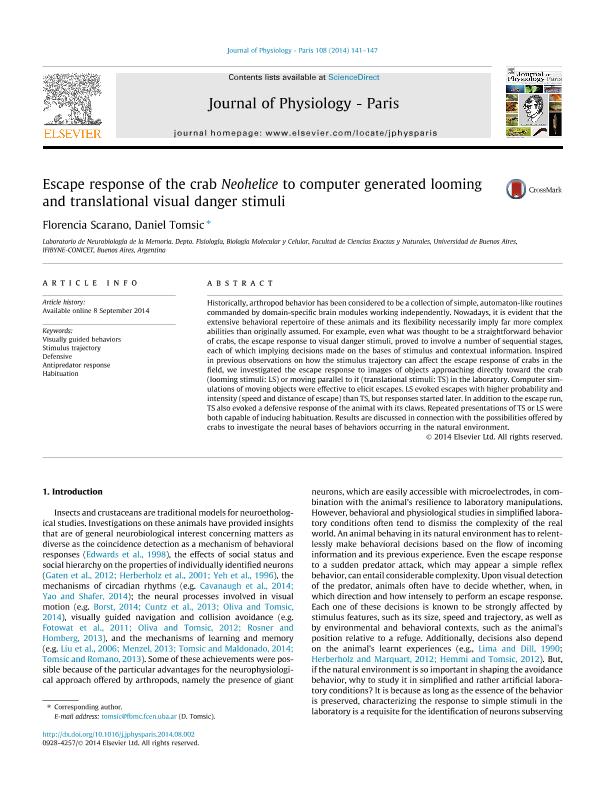Artículo
Escape response of the crab Neohelice to computer generated looming and translational visual danger stimuli
Fecha de publicación:
06/2014
Editorial:
Elsevier
Revista:
Journal of Physiology
ISSN:
0928-4257
Idioma:
Inglés
Tipo de recurso:
Artículo publicado
Clasificación temática:
Resumen
.Historically, arthropod behavior has been considered to be a collection of simple, automaton-like routines commanded by domain-specific brain modules working independently. Nowadays, it is evident that the extensive behavioral repertoire of these animals and its flexibility necessarily imply far more complex abilities than originally assumed. For example, even what was thought to be a straightforward behavior of crabs, the escape response to visual danger stimuli, proved to involve a number of sequential stages, each of which implying decisions made on the bases of stimulus and contextual information. Inspired in previous observations on how the stimulus trajectory can affect the escape response of crabs in the field, we investigated the escape response to images of objects approaching directly toward the crab (looming stimuli: LS) or moving parallel to it (translational stimuli: TS) in the laboratory. Computer simulations of moving objects were effective to elicit escapes. LS evoked escapes with higher probability and intensity (speed and distance of escape) than TS, but responses started later. In addition to the escape run, TS also evoked a defensive response of the animal with its claws. Repeated presentations of TS or LS were both capable of inducing habituation. Results are discussed in connection with the possibilities offered by crabs to investigate the neural bases of behaviors occurring in the natural environment.
Palabras clave:
Escape Response
,
Visual Behaviors
,
Looming Stimuli
,
Crabs
Archivos asociados
Licencia
Identificadores
Colecciones
Articulos(IFIBYNE)
Articulos de INST.DE FISIOL., BIOL.MOLECULAR Y NEUROCIENCIAS
Articulos de INST.DE FISIOL., BIOL.MOLECULAR Y NEUROCIENCIAS
Citación
Scarano, María Florencia; Tomsic, Daniel; Escape response of the crab Neohelice to computer generated looming and translational visual danger stimuli; Elsevier; Journal of Physiology; 108; 2-3; 6-2014; 141-147
Compartir
Altmétricas




